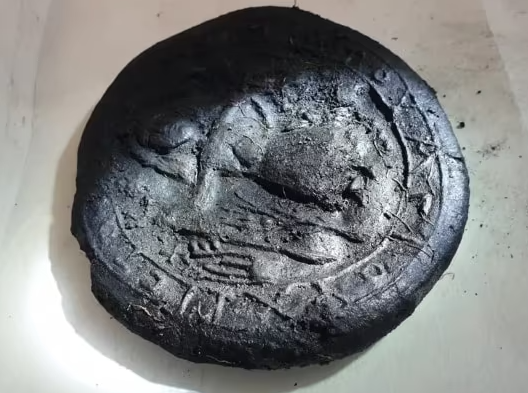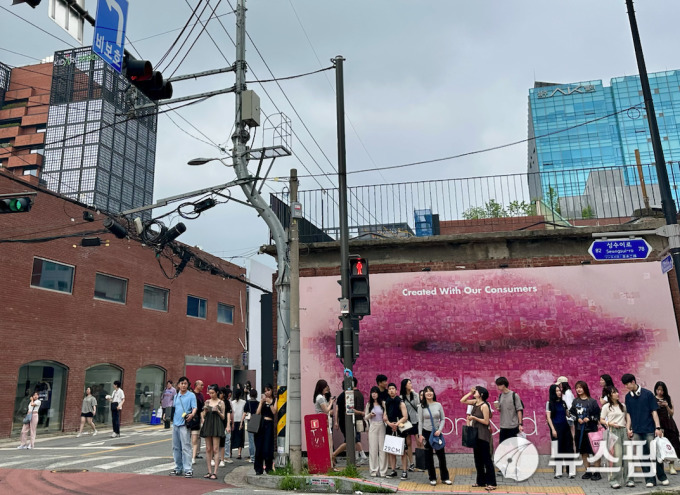
로마가 멸망한 이후 고대에서 중세로 넘어오면서 카톨릭 교회의 엄격한 지배 아래 향은 관능적이고 환락적인 영향을 미친다는 부정적 비판을 받게 된다. 중세 시대에 향이 쇠퇴하여 음식이 맛이 없어진 이유인데 십자군 전쟁 이후, 그런 관념이 바뀌게 된다. 십자군 기사들은 셀주크투르크에게 함락당한 성지, 예루살렘을 탈환하기 위해 떠났다. 이러한 십자군 원정(1096~1270) 7차례 일어났으며 십자군 원정은 동양과 서유럽 무역의 활로를 개척하는 기회가 되었을 뿐 아니라 로마, 그리스, 이집트의 향을 서유럽에 소개한 중요한 계기로 나타나고 있다. 이와 같이 되풀이되는 원정 속에서 동양과 서양의 교통도 점차로 넓어지고 후추, 육계, 정향 등 향신료가 급속히 서유럽에 퍼졌다. 특히 1202년에 발생한 제4차 십자군 원정은 십자군이 이탈리아 베네치아 상인과 합세해 콘스탄니노플을 공격해서 함락시키고 갖은 약탈을 자행했다. 그리고 비잔틴 제국을 밀어내고 점령한 콘스탄티노플에 라틴 제국을 세웠으며 라틴 제국의 건국으로 인해 동쪽으로 향한 지중해 무역권을 장악하게 되었다.
이렇게하여 베네치아는 동방 무역을 통해 동양의 비단과 자수품, 향료 등을 들여왔고 베네치아와 콘스탄티노플은 유럽에 향수와 화장품의 원료를 조달하는 창구이자 유럽에서 부와 권력의 중심지가 되었다. 성지탈환을 위해 떠났던 십자군기사들은 당시 종교적인 열망만큼이나 유럽 전체를 향수의 냄세로 향기롭게 만든 주인공들이었겠지만 아시아의 입장에서 볼 때 십자군 기사들은 남의 땅에 침범한 도적떼에 불과할 뿐이었다. 14세기에 들어 포도주와 향료가 유행하게 되는데 오늘날의 향수가 발견된 것은 바로 이러한 포도주 때문이었다. 포도주를 담그는 비법은 바로 알코올의 농도와 증류 방식이었는데 여기에서 어느 연금술사가 오랫동안 향을 유지시킬 수 있는 방법을 고민한 끝에 그 비법을 발견한 것이다. 금을 인공적으로 만드는데 실패했던 그들은 포도주 증류과정 중에 이슬람으로부터 알코올을 받아들이고 각종 향신료와 섞기 시작했던 것이다. 게다가 기존의 물, 기름등에 의한 기체보다 모든 방향 물질을 용해시키는 성질이 뛰어난 알코올은 휘발 성향을 오래 유지시켜줄 뿐 아니라 원료로만 머물렀던 향료를 드디어 '향수'라는 개념으로 끌어올리게 했다.
한편 최초의 알코올 향수는 로즈메리(Rosemary)와 수지를 증류시켜 알코올을 뽑아내고 여기에 증류 과정에서 나온 로즈메리의 잔여물을 첨가한 헝가리워터(Hungary Water)를 탄생시켰는데 이는 오늘날의 오데코롱(Eau de Cologre)의 전신이기도 하다. 1370년 최초의 알코올 향수인 헝가리워터가 탄생하면서 세계 최초의 향수가 개발된다. 여왕의 물이라 불렸던 헝가리 워터는 헝가리 판노니아의 한 수도사에 의해 개발되어 당시의 헝가리 엘리자베타 여왕에게 바쳐졌다. 여왕은 영원한 아름다움의 비결로 이 향수를 사용하였으며, 당시 72세의 늙고 추하던 여왕은 헝가리워터의 도움으로 인해 폴란드의 왕에게 청혼을 받아 결혼에 성공했다고 한다. 최초의 헝가리워터는 로즈마리에 마조람, 박하 종류인 페니로얄을 혼합한 비교적 간단한 제품으로 알려져 있다. 나중에 레몬, 라벤더, 오리스 등이 더해져 헝가리워터는 보충된 상품으로 귀족들 사이에 재출시 되었다고 한다.
콜럼부스, 바스코 다 가마, 마젤란 등이 미지의 바다에 도전했던 이유는 뭘까? 그것은 향료 군도를 찾아 인도와의 교역을 위해서였다. 이는 단지 관세를 물지않고 인도나 동남아시아 등지로부터 향료를 누구의 방해를 받지 않고 가져오기 위해 서쪽으로 항해를 떠났던 것이다. 당시 후추, 계피, 전향유 같은 향료는 저장한 고기, 생선의 부패를 막아주었으며 맛을 좋게했을 뿐 아니라 유럽에서 유행했던 흑사병(페스트)나 콜레라 등의 전염병을 방지한다고 믿었을 정도로 약품으로도 이용되었다. 이러한 향료는 금은보화와 맞바꿀수 있을 정도의 대단한 재화 가치를 가졌던 것이다. 지동설을 받아들여 지구가 둥글다는 확신 만으로 망망대해를 항해했던 항해가들 배후에는 항해권을 독점하면서 막대한 재산을 챙기려는 당시 포르투칼, 스페인 왕과 귀족들의 야망 또한 뒷받침했다.
한편 1508년 이탈리아 플로렌스 성 마리베라의 도미니카회 수도사는 피렌체에 있는 향수 조제 작업실이며 각종 수제화 작업실인 아뜨리에(Atelier)에서 유리향수(Glass Perfume)를 만들어 당시 유럽 상류층들에게 큰 인기를 끌었다. 1533년 프랑스 앙리 2세 때 파리 노트르담 성당 근처에서 제1호 향수 전문점이 오픈한 이후 향수 종류의 판매와 중심지는 이탈리아에서 비로소 파리로 옮겨졌던 것으로 보인다. 르네상스 시대에 들어 인간의 신체에 대한 관심이 높아짐에 따라 향수를 화장과 청결의 용도로 사용하고자 하는 욕구가 많았다. 이러한 향수의 사용은 당시까지 귀족 계급의 전유물이었지만, 조금씩 일반 대중들의 생활 속으로도 침투하기 시작하였다. 16세기 후반에 이탈리아 피렌체에 자리한 메디치 가문은 르네상스 문명을 후원하여 문화의 절정을 일구었으며 향수와 화장품 문화를 주도하게 된다. 1533년 메디치 가문의 카트린 드 메디시스(Catherine de Médicis, 1519~1589) 공주가 프랑스 왕 앙리 2세와 결혼하면서 세련된 이탈리아 향수 문화가 프랑스로 이동했다.
카트린 드 메디시스는 프랑스 향수 산업의 창시자로 간주되고 있다. 이에 메디치 가문의 전속 조향사인 레나토 비앙코(Renato Bianco)는 카트린 공주와 동행하여 파리에서 가게를 열기도 하였다. 그녀는 또한 피혁 산업이 발달한 남프랑스 그라스(Grasse) 지역에도 대규모 향수 산업을 일으켰는데, 이는 그 당시 향수 산업이 발달된 아라비아 지역을 의식한 것으로 해석되고 있다. 18세기에는 프랑스 궁정을 중심으로 하여 온갖 사치스런 향수 문화가 발달한 시기이기도 했다. 루이 14세는 당시 최고의 향기를 풍기는 제왕이라고 불려졌지만 이는 목욕을 하지 않아 몸에 나는 악취를 덮기 위해 뿌렸던 것으로 의혹을 받고 있다. 이후 루이 15세 시대는 프랑스 궁정은 ‘향기의 궁정’으로 불릴 정도로 향수를 많이 사용하였는데 이 또한 목욕문화가 거의 없던 프랑스 귀족사회에서 궁정에 나는 악취를 덮기 위한 용도로 알려지고 있다. 이후 19세기는 천연향료에서 합성향료의 시대로 변질되었으며 불과 150가지의 향과 향수를 오늘날 4,000여 가지 이상의 물질을 추출할 수 있게했다. 그리고 다양한 제조 방법으로 인해 비로소 향수의 대중화가 시작되었다.
*필자/ 정길선.
노바토포스 회원, 역사학자, 고고인류학자, 칼럼니스트, 러시아 과학아카데미 유라시아 고고인류학연구소 연구교수.
*아래는 위 기사를 '구글 번역'으로 번역한 영문 기사의 [전문]입니다. '구글번역'은 이해도 높이기를 위해 노력하고 있습니다. 영문 번역에 오류가 있을 수 있음을 전제로 합니다.<*The following is [the full text] of the English article translated by 'Google Translate'. 'Google Translate' is working hard to improve understanding. It is assumed that there may be errors in the English translation.>
Stories about perfumes passed down from the Crusades to the present
Columnist Jeong Gil-seon
After the fall of Rome, as we transitioned from ancient times to the Middle Ages, under the strict rule of the Catholic Church, perfumes were criticized for having a sensual and hedonistic influence. This is why perfumes declined in the Middle Ages and food became tasteless, but this perception changed after the Crusades. The Crusader knights set out to recapture Jerusalem, the Holy Land, which had fallen to the Seljuk Turks. These seven Crusades (1096-1270) occurred, and they not only provided an opportunity to open up trade routes between the East and Western Europe, but also served as an important opportunity to introduce the perfumes of Rome, Greece, and Egypt to Western Europe. Through these repeated expeditions, traffic between the East and the West gradually expanded, and spices such as pepper, cinnamon, and cloves rapidly spread to Western Europe. In particular, the Fourth Crusade in 1202 saw the Crusaders join forces with Italian Venetian merchants to attack and capture Constantinople, and commit all sorts of plunder. They then pushed out the Byzantine Empire and established the Latin Empire in Constantinople, which they occupied, and with the establishment of the Latin Empire, they gained control of the Mediterranean trade toward the east.
In this way, Venice imported oriental silk, embroidery, and spices through oriental trade, and Venice and Constantinople became the gateways for supplying raw materials for perfumes and cosmetics to Europe, as well as the centers of wealth and power in Europe. The Crusaders who set out to reclaim the Holy Land were the protagonists who made the entire Europe smell like perfume, as much as they were religiously zealous, but from the perspective of Asia, the Crusaders were nothing more than a band of thieves who invaded someone else's land. In the 14th century, wine and spices became popular, and today's perfumes were discovered because of this wine. The secret to making wine was the concentration of alcohol and the distillation method, and here, an alchemist discovered the secret after pondering over a way to maintain the scent for a long time. Having failed to artificially create gold, they accepted alcohol from Islam during the wine distillation process and began mixing it with various spices. In addition, alcohol, which has a superior property of dissolving all aromatic substances than existing gases such as water and oil, not only maintains the volatile tendency for a long time, but also finally elevated the concept of fragrance, which had been limited to raw materials, to 'perfume'. Meanwhile, the first alcohol perfume was created by distilling rosemary and resin to extract alcohol, and adding the residue of rosemary from the distillation process to create Hungarian Water, which is also the predecessor of today's Eau de Cologne. In 1370, the world's first perfume was developed when the first alcohol perfume, Hungarian Water, was created. Hungarian Water, called the Queen's Water, was developed by a monk in Pannonia, Hungary and presented to Queen Elisabeth of Hungary at the time. The queen used this perfume as the secret to her eternal beauty, and it is said that the old and ugly queen at the time, 72 years old, successfully proposed to the King of Poland and got married thanks to the help of Hungarian Water. The first Hungarian Water is known to be a relatively simple product that mixed rosemary, marjoram, and pennyroyal, a type of mint. Later, lemon, lavender, and orris were added, and Hungarian Water was re-launched among the nobility as a supplemented product.
Why did Columbus, Vasco da Gama, and Magellan challenge the unknown sea? It was to find the Spice Islands and trade with India. They simply sailed west to bring spices from India and Southeast Asia without paying customs and without being hindered by anyone. At that time, spices such as pepper, cinnamon, and clove oil prevented the spoilage of stored meat and fish, and not only improved the taste, but they were also used as medicines to the extent that it was believed to prevent infectious diseases such as the Black Death (plague) and cholera that were prevalent in Europe. These perfumes had such great value that they could be traded for gold and silver. Behind the sailors who accepted the heliocentric theory and sailed the vast oceans with the conviction that the Earth was round, the ambitions of the kings and nobles of Portugal and Spain at the time to monopolize navigation rights and make huge fortunes also supported them. Meanwhile, in 1508, the Dominican monks of St. Mary's in Florence, Italy, created glass perfume at the Atelier, a perfumery and handmade shoe workshop in Florence, which was very popular among the upper classes of Europe at the time. After the first perfume shop opened near Notre Dame Cathedral in Paris in 1533 during the reign of Henry II of France, the sales and center of perfume seem to have moved from Italy to Paris. As interest in the human body increased during the Renaissance, there was a growing desire to use perfume for makeup and cleansing purposes. The use of these perfumes had been exclusive to the aristocracy until then, but they gradually began to penetrate into the lives of the general public. In the late 16th century, the Medici family, which was based in Florence, Italy, supported the Renaissance civilization and reached the peak of culture, and led the perfume and cosmetics culture. In 1533, Catherine de Médicis (1519-1589), a princess of the Medici family, married King Henry II of France, and the sophisticated Italian perfume culture moved to France. Catherine de Médicis is considered the founder of the French perfume industry. Renato Bianco, the exclusive perfumer of the Medici family, accompanied Catherine to open a shop in Paris. She also established a large-scale perfume industry in Grasse, a region in southern France with a developed leather industry, which is interpreted as being conscious of the Arabian region where the perfume industry was developed at the time. The 18th century was also a time when all kinds of luxurious perfume cultures developed, centered around the French court. Louis XIV was called the emperor with the best fragrance at the time, but it is suspected that this was because he sprayed perfume to cover up the bad smell from his body because he did not bathe. Later, during the reign of Louis XV, the French court was called the “court of fragrance” because perfume was widely used. This is also known to have been used to cover up the bad smells in the court in the French aristocratic society where bathing culture was almost non-existent. After that, the 19th century changed from natural fragrances to the era of synthetic fragrances, and it became possible to extract more than 4,000 substances from only 150 types of fragrances and perfumes today. And the popularization of perfume began with various manufacturing methods.


![[역사문화권 특별법 5관왕 장수군 속살 들추다] (9)후백제 때 부처가 교화하는 불국토 아니었을까?](https://www.domin.co.kr/news/photo/202510/1532666_729766_1638.jpg)


![[세계타워] ‘풍선효과’ 악순환 언제까지](https://img.segye.com/content/image/2025/10/22/20251022518150.jpg)

![[여명] "7년 고난이 나를 키웠다"…習의 하방, 中의 반격](https://newsimg.sedaily.com/2025/10/21/2GZ9KJSL4Z_1.jpeg)